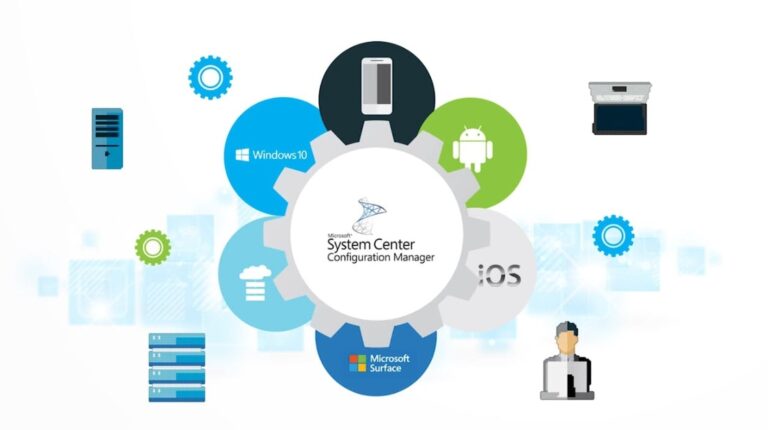Understanding SCCM: What is SCCM Used For?
Businesses require tools to manage basic operations quickly on a broader scale, saving time and costs. If you own a startup or a well-established business, you must have heard of Microsoft’s System Center Configuration Manager(SCCM) management suite.
If you are curious about what SCCM is used for and how it can be beneficial to your business, then follow this post.
We have explained its workings and shared which alternative is better suited to manage Android devices on a larger level, which is also cost-effective and easy to use.

1What is SCCM and What is it Used for?
System Center Configuration Manager (SCCM) is a comprehensive management tool developed by Microsoft. It lets businesses manage, deploy, and apply device security measures quickly across the whole enterprise. The primary function is to allow administrators to apply endpoint protection, update device applications, and distribute software.
Key Features
- Windows Management: Allow businesses to keep up with all Windows-related updates on all company-owned computers.
- Endpoint Protection: Identify potential malware and protects the devices accordingly.
- Software Update Management: The administrators manage application or software update devices across the whole enterprise.
- Reporting: Share details on the user, the hardware being managed, the software deployed, and info on their updates.
- Software Update Management: Administrators can deliver an application on all company-operated devices.
2How Does SCCM Help with Businesses?
IT operations are essential to keep the business running in this modern era. However, the ever-growing demand and the need to deploy security measures across several devices can be a bit overwhelming.
SCCM is a versatile tool that helps organizations manage their IT infrastructure efficiently. It streamlines processes, ensures compliance, and provides robust reporting capabilities.
1Centralized Management
SCCM provides a centralized platform to manage all devices within an organization, including desktops, servers, laptops, and mobile devices. This centralization simplifies administration and ensures consistency across the IT environment.
Malware issues and security lapses are a headache for IT departments and businesses, making it all the more vital that company-owned devices are equipped with the latest security patches. Again, this process can cost time and resources, which can be eliminated using SCCM. This tool allows the deployment of all patches simultaneously.
2Software Deployment
SCCM automates the deployment of software applications, updates, and patches. This ensures that all systems are up-to-date with the latest software, reducing vulnerabilities and improving performance.
For example, CRM platforms are quite essential for a company’s sales team. Instead of manually adding this important tool to each device, SCCM can install it all at once based on a schedule set by the IT department.

3Compliance and Settings Management
SCCM helps enforce compliance policies and configurations across all managed devices. This ensures that devices adhere to corporate policies and regulatory requirements.
4Remote Control
SCCM includes remote control features that allow IT administrators to troubleshoot and resolve issues on client machines without needing physical access, improving response times and reducing downtime.

5Endpoint Protection
SCCM integrates with Microsoft Defender to provide robust endpoint protection. It helps in managing and monitoring security policies, ensuring that all endpoints comply with the organization's security standards.
3Benefits and Limitations of SCCM
SCCM is a powerful tool for managing large and complex IT environments, offering a wide range of features that enhance device management, improve security, and compliance. However, its complexity, cost, and resource requirements may pose challenges for some organizations. Proper planning, training, and resource allocation are essential to fully leverage the benefits of SCCM.
Benefits of SCCM
Centralized Management
With this tool, businesses can manage all company-owned devices, no matter which platform, under a unified platform. This saves time and makes it easier to deploy apps and software and manage their updates.
Enhanced Security
Manually controlling each device is hectic and opens room for security lapses, like malware or hacking attempts. SCCM’s automated patch management and system updates prevent any such inconveniences.
Integration with Other Microsoft Products
It integrates seamlessly with other Microsoft products and services, such as Active Directory, Azure, and Windows Update, enhancing its functionality and ease of use.

Limitations of SCCM
Complexity and Learning Curve
Despite the convenience SCCM brings for businesses, its limitations are quite noticeable as well. We have highlighted some key benefits and disadvantages of this tool.
Cost
The licensing and implementation costs of SCCM can be high, making it less suitable for smaller organizations with limited budgets.
Resource Intensive
SCCM requires substantial server and network resources to operate efficiently, which can be a challenge for organizations with limited infrastructure.
Compatibility Issues with Older Versions
Older versions of SCCM, such as SCCM 2012 and SCCM 2012 R2, are not fully compatible with the latest features of Windows 10. These versions will not support new Windows 10 features in the future. Organizations using these versions will need to upgrade to the latest SCCM versions to maintain full functionality.
SCCM is a powerful tool for managing large and complex IT environments, offering a wide range of features that enhance device management, improve security, and compliance. However, its complexity, cost, and resource requirements may pose challenges for some organizations. Proper planning, training, and resource allocation are essential to fully leverage the benefits of SCCM.
4Try SCCM Alternative - Airdroid Business Solutions
While System Center Configuration Manager (SCCM) is a popular choice for many organizations, it may not always meet the specific needs of every business. If you're looking for a robust SCCM alternative, consider AirDroid Business UEM solutions. Unlike SCCM cannot deploy configuration settings to mobile devices, AirDroid Business is a cost-effective solution for businesses that provides an all-in-one mobile device configurations. It designed with a user-friendly interface, making it easier to set up and manage, especially for businesses with limited IT resources.
Key Features
- Cost-Effective: Compared to SCCM, AirDroid Business is a cost-effective solution. It offers flexible pricing plans that cater to different business sizes and needs, ensuring you only pay for what you use.
- User-Friendly Interface: It is designed to be intuitive, making it easy for IT administrators to manage devices, deploy updates, and monitor performance without extensive training.
- Flexibility: Offer a flexible solution that can be tailored to your specific needs.
- Kiosk Mode: Control the users’ browsing environment by defining the App allowlist and customizing the browser settings.
Conclusion
Now you know what SCCM is used for and how it can benefit your enterprise. While SCCM is a powerful tool, it may not be the best fit for every organization. However, compatibility issues and expensive packages make it less ideal for startups and mid-tier businesses. By choosing the SCCM alternative - AirDroid Business, you can streamline your device management processes, enhance security, and improve overall operational efficiency.
Frequently Asked Questions
Since SCCM is a Microsoft-based platform, it is compatible with all products that are essential to a running business.
For Office 365, SCCM manages Office 365 applications and services, ensuring that all applications are installed up-to-date and compliant with organizational policies, facilitating seamless deployment and updates of Office 365 applications, and ensuring compliance with organizational requirements.
As for Microsoft SQL Server, SCCM uses its backend database to store configuration data, asset information, and reporting data. Moreover, it is integrated with Microsoft Azure to assist with cloud-based services.










Leave a Reply.